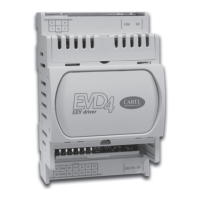42
Controller
Output
100%
error
proportional band
full-scale error
Controller
Output
100%
error
proportional band
full-scale error
Fig. 3
step
e (t)
band prop.= 100
step max
Fig. 4
ENGLISH
EVD
4
+030220227 - rel. 2.1 - 12.06.2008
intense the action on the process so as to bring the controlled variable to the desired value.
It is important to note that this has a value other than zero only if the error is not zero: therefore, in
steady operation this is ideally zero. In reality, in steady operation (stable at the set point) it still follows
the fl uctuations in the controlled variable due, for example, to measurement noise, and it can be shown
that alone it may not reach the set point, maintaining a certain deviation from the latter.
The proportional action makes its contribution in the initial transient periods; then, when the error
decreases, it loses effectiveness.
To determine the proportional gain K, consider the relationship between the input and output of a
controller to be purely proportional, as shown in the fi gure, for two values different of the gain, where
the input and the output are represented as percentages of their fi eld of variation:
Defi ning the variation in the input (as a percentage of its fi eld of variation) as the proportional band BP
that causes a 100% variation in the output, if the input and output signals have the same physical type
and vary within the same fi eld of values (for example 4 to 20 mA), the gain K is:
K
p
=
100
BP%
In the fi rst diagram in Fig. 3, Bp=50%, hence Kp=2, while in the second BP=10% and thus Kp=10. The
proportional action of the PID controllers is set by the operator as the proportional band changes.
EXAMPLE: Consider the case of a controller with a 4 to 20 mA input and 0 to 10 V output: when
BP=10%, a 1.6 mA variation in the input produces a variation from 0 to 10 V at the output, that is, the
total gain is 10/1.6=6.25 V/mA.
In the case of the SH PID:
valve pos. (SH set point – SH measured(t))
K= ± 20%
step max reg Q circuit
•
100
Q valve
where:
step max reg = maximum electronic expansion valve control steps
Q circuit = capacity in kW of the refrigerant circuit in steady operation
Q valve = capacity in kW of the electronic expansion valve in the same operating conditions as Q
circuit
IV.IV Integral action
EFFECT OF Ti
Increasing the value of the integral time Ti, the valve reaches the set point more slowly but
avoids excessive swings. This depends on the type of evaporator and the inertia of the circuit.
The integral action is used to guarantee that the error is null in steady state. Indeed, the integral action
is not zero if there is no error; quite the opposite, if for example the error remains stable, it continues to
increase linearly, following the principle whereby “until the controlled variable decides to move in the
direction I want, I will continue to apply an increasingly intense action”. Consequently, the integral action
not only considers the current value, at the instant of the error, but also the past values.
As a result, if steady state is reached, that is, the error is null, the only contribution to control will be the

